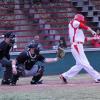2 BRD Plays - Force Play Slide Rule
Umpire-Empire locks topics which have not been active in the last year. The thread you are viewing hasn't been active in 4777 days so you will not be able to post. We do recommend you starting a new topic to find out what's new in the world of umpiring.
-
Similar Content
-
- 1 answer
- 1,116 views
-
- 24 replies
- 3,418 views
-
- 25 replies
- 3,636 views
-
- 104 replies
- 7,468 views
-
- 9 replies
- 2,552 views
-




Recommended Posts